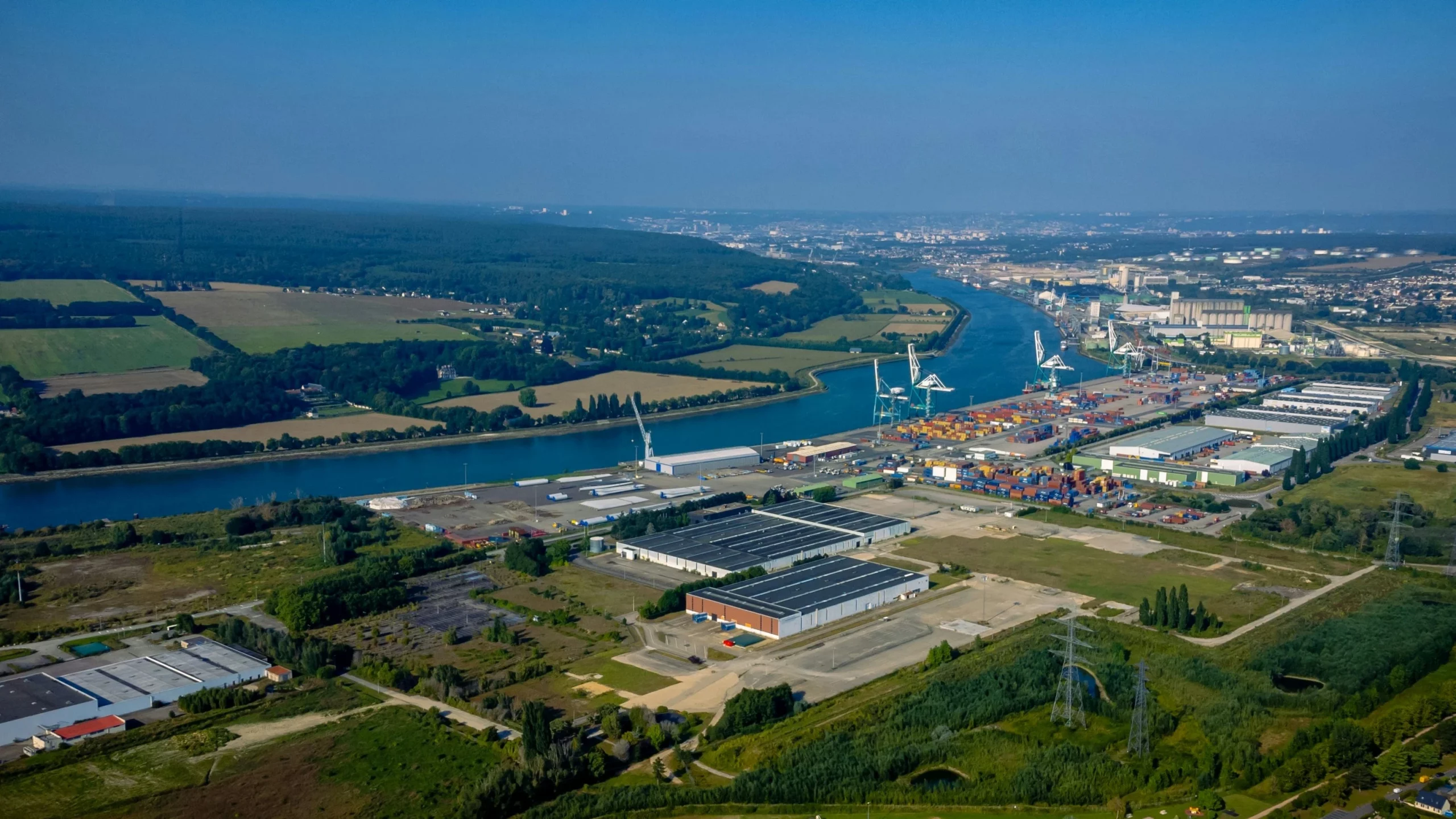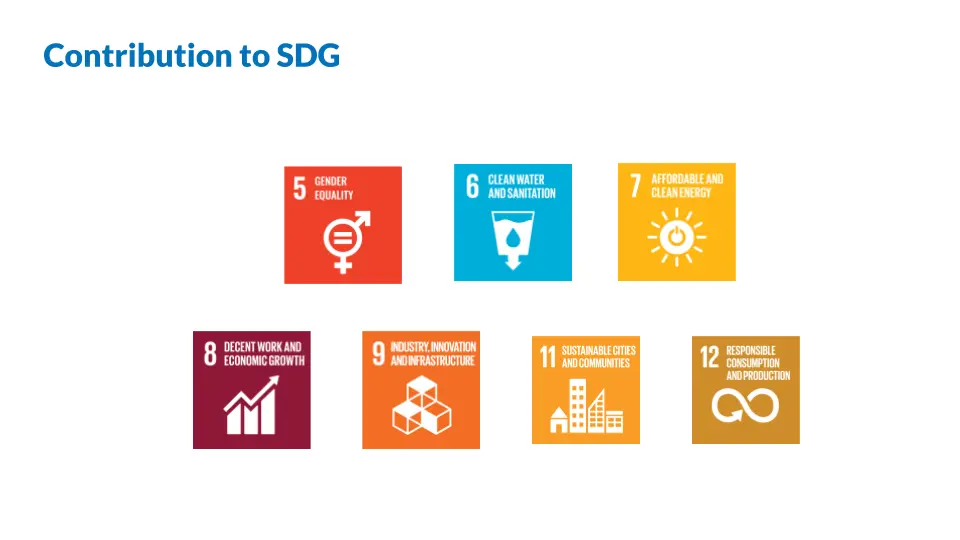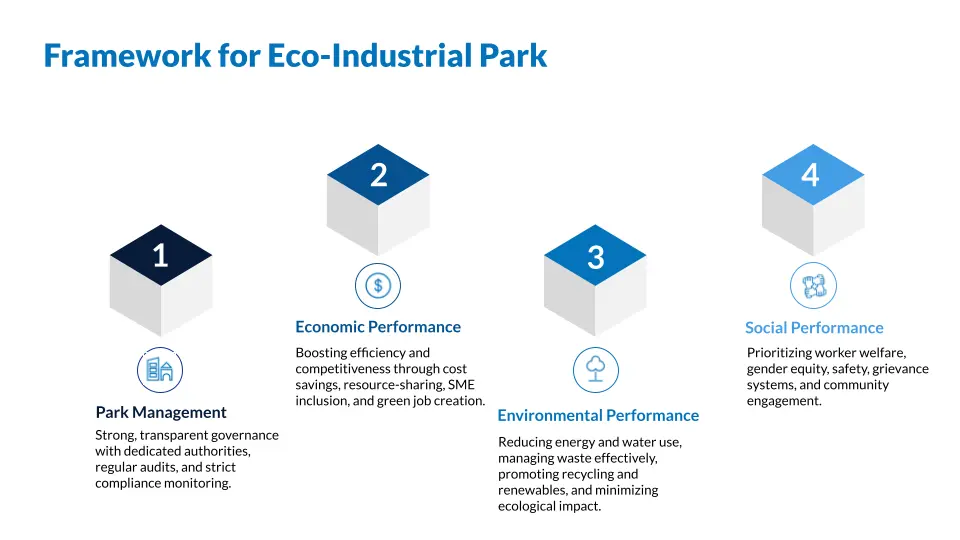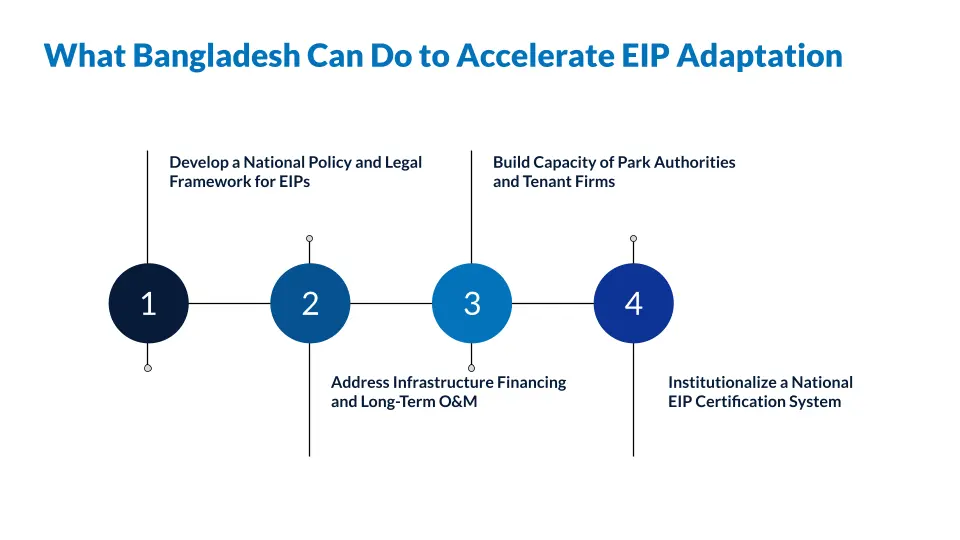GET IN TOUCH
- Please wait...

Eco-Industrial Parks (EIPs) are an effective approach to industrial development that emphasizes resource efficiency, reduced water usage, and sustainable management of industrial ecosystems. EIP establishes a network of businesses for efficient resource sharing, which results in a circular ecosystem within industrial parks.
In today’s world, this resource efficiency and environmental sustainability offered by EIPs matter significantly, as traditional industrial parks often cause serious environmental harm by polluting water, air, and land, and contributing to climate risks.
With the global investment ecosystem shifting towards strict adherence to ESG concerns and climate responsibility, Bangladesh faces an urgent need to transition toward sustainability to maintain its export competitiveness and attract global green financing.
According to the International Framework for Eco-Industrial Parks, “EIPs can be defined as managed industrial areas that promote cross-industry and community collaboration for common benefits related to economic, social, and environmental performance.”
In simple words, an EIP is an industrial area where companies share resources in a way meant to reduce waste, maximize resource efficiency, reduce emissions, and raise the well-being in communities where they operate on a financially competitive basis. Key discussions of EIP revolve around –

1. Consistently Deteriorating Environment: Bangladesh’s industrial sector has been the engine of its economic transformation. It contributed to 34.1% of GDP1 and employed nearly 12.75 million people,2 primarily in export-oriented manufacturing in FY25.
However, this industrialization has been at a very steep environmental cost:
This environmental degradation not only threatens ecological sustainability but also undermines economic competitiveness.

2. Mounting Compliance Pressure: One of Bangladesh’s principal export markets, the European Union, is fortifying environmental laws. In the European Green Deal, all imports are required to comply with high environmental and labor compliance standards. The Carbon Border Adjustment Mechanism from 2026 will impose a carbon price on non-similarly carbon-priced countries for iron/steel, cement, fertilizers, aluminum, hydrogen, and electricity.
Large brands are already calling on their suppliers for emissions disclosure and proof of climate strategies. Ignoring these demands may yield loss of market access, reduction in orders, or price fines. Considering the European market is increasingly becoming more important, Bangladesh must move fast to maintain the compliance the European market requires.
3. Shifting Investor Priority Towards Green Finance: There is a strong global push from donors and development financiers to support sustainable industrial development. The World Bank and IFC both focus on green infrastructure projects. UNIDO’s GEIPP programme has demonstrated EIPs’ potential in countries like Vietnam and South Africa. ‘
The Green Climate Fund (GCF) and Global Environment Facility (GEF) have earmarked billions globally for climate-resilient industrial transformation, which can be accessible to Bangladesh with the right institutional mechanisms.6
Overview of Industrial Zones in Bangladesh: Currently, industrial parks fall under three main categories, each managed by a different authority:

Industrial parks in Bangladesh barely have adequate environmental protection. The Dhaka-Narayanganj-Tongi industrial corridor, one of the largest industrial belts in the country, is the source of over 60 percent of the pollution in the rivers Buriganga, Balu, and Turag, the lifelines of the capital city.⁷

According to the International Framework for Eco-Industrial Parks, EIP performance is assessed based on four themes – Park Management, Economic Performance, Environmental Performance, and Social Performance.

Vietnam: Accelerated Sustainability through Pilot EIPs
Vietnam has emerged as a leader in Asia in integrating sustainability into its industrial policy. With the help of the UNIDO-supported Global Eco-Industrial Parks Programme (GEIPP), Vietnam launched pilot EIPs in the Da Nang, Can Tho, and Ninh Binh provinces.⁸
Key Effects: Innovation in the pilot sites has allowed 72 businesses to save more than 22,000 MWh of electrical power, 600,000 m³ of water, 140 terajoules (TJ) of fossil fuel, nearly 3,600 tonnes of chemicals and wastes, and more than VND76 billion (US$2.99 million) a year.⁹
China: Scaling EIPs with Policy-Driven Precision
China has initiated one of the world’s largest EIP programmes with over 73 officially accredited Eco-Industrial Parks by 2024.¹⁰ Such parks are the pillars behind the country’s overall push towards low-carbon, resource-efficient, and pollution-free industrialization. China set strict parameters for EIPs from the UNIDO guidelines. ‘
The parks are regularly monitored and mandated to report on over 50 parameters, including recycling, utilization of energy, and employee welfare.
Key Outcomes: This resulted in 85% waste being reused, a reduction of energy by 30%, and the parks gaining large green funds, especially in EVs and clean tech.
To transition from traditional industrial parks to fully functional EIPs, Bangladesh must undertake a series of systemic changes across multiple dimensions.

1. Develop a National Policy and Legal Framework for EIPs
Bangladesh lacks a common national policy and legislation on Eco-Industrial Parks currently. There are entities like BEZA, BEPZA, and BHTPA that are actively developing industrial estates, but there is no compliance requirement being maintained with internationally recognized EIP principles like the UNIDO–World Bank–GIZ Framework from 2021.
At present, there is no definition by law, and no mandated performance criteria that apply to EIPs. Environmental and economic sustainability will require a national EIP policy aligning with the government’s Climate Action Plan, Industrial Policy, and SDGs.
Lessons from Vietnam: Vietnam provides a good example of the incorporation of EIP at the national level. A formal EIP policy was launched by the government of Vietnam through the Ministry of Planning and Investment in 2020 in association with UNIDO.¹¹ The policy integrates environmental and social performance indicators into park design and rewards resource-efficient technology.
2. Address Infrastructure Financing and Long-Term O&M (Operation and Maintenance)
Developing Eco-Industrial Parks in Bangladesh is slowed down due to significant upfront costs for infrastructure like CETPs, solar systems, waste exchange platforms, and green transport corridors. Currently, there is no dedicated financing model for the long-term operation and maintenance of shared EIP facilities.
To address this, Bangladesh needs blended finance mechanisms that combine government investment, concessional climate finance, and private investment. EIP infrastructures should be supported by tools like green bonds, GTF by Bangladesh Bank, and access to international sources such as the Green Climate Fund (GCF).
Lessons from India: India is making significant progress in EIP financing through its Green National Industrial Corridors initiative. Zones like the Delhi–Mumbai Industrial Corridor include dedicated funding for CETPs, solar infrastructure, and waste recovery systems, supported by ADB and the Government of India12.
3. Build Capacity of Park Authorities and Tenant Firms
Lack of technical capacity is a key barrier to EIP adoption in Bangladesh. Most park authorities and tenant firms lack awareness of cleaner production, industrial symbiosis, or ESG standards. To close this gap, Bangladesh should establish a National EIP Training Academy under BEZA, in partnership with Bangladesh Standards and Testing Institute, the Department of Environment, and industry groups. Regular training for park staff and incentive-backed programs for tenant firms can build the skills needed for EIP-scale transformation.
Lessons from South Africa: South Africa’s Industrial Symbiosis Programme (SIP), run by the National Cleaner Production Centre, trains park managers and companies to identify resource-sharing opportunities and improve efficiency. It has enabled over 1,000 industrial linkages, reduced waste, and cut costs for firms. 13
4. Institutionalize a National EIP Certification System
For building investor confidence and encouraging green industrialization in the country, there is a need for a national EIP certification scheme in consonance with global standards. The same should include clear performance indicators in the environmental, economic, social, and management pillars, along with third-party audit and online reporting.
This certification should be included in the BEZA and BEPZA approval process. Such a mechanism will facilitate standardization of the quality for EIP in addition to enticing green investment and harvesting associated financial potential.
Lessons from China and Vietnam: China’s national EIP program has over 50 KPIs and links certification with tax incentives, building park-level accountability. Vietnam’s pilots in the GEIPP program are building national standards linked with industrial policy, showing the importance of such certification through incentivizing performance.
Bangladesh’s industrial future needs to be equally economically sound and environmentally sustainable. Eco-Industrial Parks offer a proven template to achieve this balance by reducing pollution, improving resource efficiency, and attracting international green finance.
EIPs have the potential to transform industrial parks into sustainable growth hubs with the right policy driver, financing instruments, and institutional capacity. It’s high time the country taps into EIPs as a smart economic strategy towards Bangladesh’s next development trajectory.
Shoumik Shahriar, Project Manager and Senior Business Consultant at LightCastle Partners, authored up this article. For any queries, kindly reach out to [email protected].
Our experts can help you solve your unique challenges
Stay up-to-date with our Thought Leadership and Insights